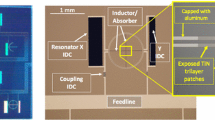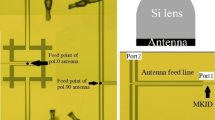Abstract
We present an antenna-coupled Kinetic Inductance Detector for millimeter wave astronomy. Next-generation telescopes for observing the cosmic microwave background are demanding in terms of number of detectors and focal plane area filling efficiency. Moreover, foreground reduction in B-Mode polarimetry requires sky observation with multiple frequency bands. In this context, KIDs are a promising technology because of their large multiplexing rate, while antenna coupling can provide multi-band and dual-polarization solutions in compact design. We have developed polarization-sensitive dual-band pixel at 140 and 160 GHz with a bandwidth of almost 8% for each sub-band. The design involves a microstrip-excited slot antenna and two open-stub band-pass filters to direct the signal toward two resonators. These are lumped elements capacitively coupled to the antenna and include an aluminum strip as absorber. The architecture proposed is particularly simple to fabricate, via-less and only involves two metallization levels. The transition does not require any dielectric deposition above the resonator, thus preventing limitations from any source of noise due to a non-monocrystalline substrate. Furthermore, the same coupling technique can be applied to many types of microstrip-excited antennas, which allow to accommodate band-pass filters.





Similar content being viewed by others
References
CMB-S4 Collaboration, CMB-s4 Science Book First Edition (2016)
J. Gao, M. Daal, J. M. Martinis, A. Vayonakis, J. Zmuidzinas et al., A semi-empirical model for two-level system noise in superconducting microresonators. Appl. Phys. Lett. 92, 212504 (2008). https://doi.org/10.1063/1.2937855
N. Behdad, K. Sarabandi, A wide band slot antenna design employing a fictitious short circuit concept. IEEE Trans. Antennas Propag. 53, 1 (2005)
S. Doyle et al., J. Low Temp. Phys. (2007). https://doi.org/10.1007/s10909-007-9685-2
Johnson et al., in Proceedings of SPIE Volume 9914, Millimeter, Submillimeter, and Far-Infrared Detectors and Instrumentation for Astronomy (2016). https://doi.org/10.1117/12.2233243
D. Mattis, J. Bardeen, Theory of the anomalous skin effect in normal and superconducting metals. Phys. Rev. 111, 142 (1958). https://doi.org/10.1103/PhysRev.111.412
A. Tartari et al., J. Low Temp. Phys. 184, 167 (2016). https://doi.org/10.1007/s10909-015-1421-8
Author information
Authors and Affiliations
Corresponding author
Rights and permissions
About this article
Cite this article
Traini, A., Tartari, A., Bordier, G. et al. Dual-Color Antenna-Coupled LEKID for Next-Generation Multi-chroic CMB Focal Planes. J Low Temp Phys 193, 170–175 (2018). https://doi.org/10.1007/s10909-018-2038-5
Received:
Accepted:
Published:
Issue Date:
DOI: https://doi.org/10.1007/s10909-018-2038-5




